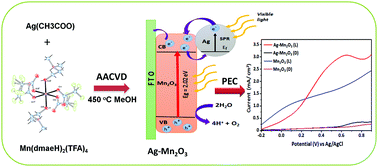Fabrication of pristine Mn2O3 and Ag–Mn2O3 composite thin films by AACVD for photoelectrochemical water splitting†
Abstract
Pristine Mn2O3 and Ag–Mn2O3 composite thin films have been developed on fluorine doped tin oxide (FTO) coated glass substrates at 450 °C by aerosol assisted chemical vapor deposition (AACVD) using a methanol solution of a 1 : 2 mixture of acetatoargentate(I), Ag(CH3COO), and a newly synthesized manganese complex, [Mn(dmae)2(TFA)4] (1) (dmae = N,N-dimethylaminoethanolate, TFA = trifluoroacetate). The phase purity and stoichiometric composition of the films were investigated by X-ray diffraction (XRD) and Raman spectroscopy techniques. Energy dispersive X-ray (EDX) and X-ray photoelectron spectroscopy (XPS) analyses revealed a Ag to Mn ratio of 1 : 2 and further confirmed the uniform dispersion of Ag nanoparticles into the Mn2O3 structure. Optical studies showed a direct band gap of 2.0 eV for the pristine Mn2O3 film that was lowered to 1.8 eV for Ag–Mn2O3 due to the plasmonic interaction of Ag with Mn2O3. The Ag–Mn2O3 composite film displayed enhanced photocatalytic activity in photoelectrochemical (PEC) water splitting and yielded a photocurrent of 3 mA cm−2 at 0.7 V versus Ag/AgCl which was 1.6 times higher than a pristine Mn2O3 film alone, under AM 1.5 G illumination (100 mW cm−2). The high PEC efficiency is mainly due to the plasmonic effect of Ag nanoparticles, which enhances the visible light absorption, efficient electron–hole separation and high carrier mobility of the Ag–Mn2O3 photoelectrode. The charge carrier density of Ag–Mn2O3 is two times higher than the pristine Mn2O3 as calculated by the Mott–Schottky plot. Based on the PEC studies a mechanism is proposed to elucidate the high activity of Ag–Mn2O3 in PEC water splitting.



 Please wait while we load your content...
Please wait while we load your content...